Botswana Wildlife Spectacular Photography Tour Report 2021
28 December 2021




























































We found no less than eight different leopards during our 2021 Botswana tour (image by Bernd Rohrschneider)
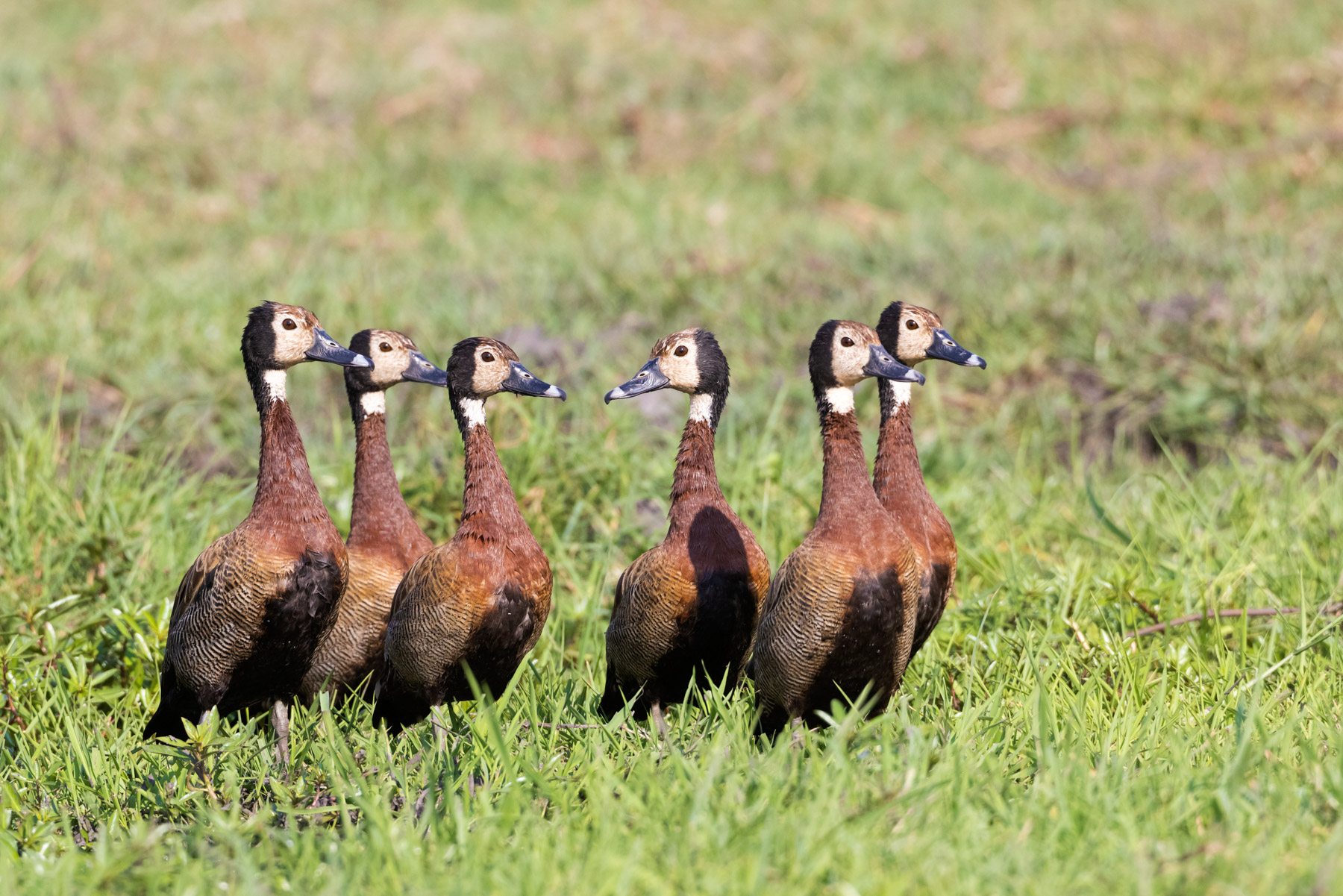
There’s always that one who decides to swim against the crowd. A flock of White-faced Whistling Ducks in the marshlands of the Chobe River (image by Bernd Rohrschneider)

Well zebras aren’t always so nice to each other. Sometimes they kick and bite! (image by Bernd Rohrschneider)

A Yellow Mongoose eyes off our safari vehicle (image by Bernd Rohrschneider)

It’s a tough life being a leopard in Botswana. Yawning leopard (image by Bernd Rohrschneider)

A majestic male Lechwe emerges from the grasslands at sunrise (image by Bernd Rohrschneider)

With the heat of the impending summer, a swim across the river is a welcome relief for elephants (image by Bernd Rohrschneider)

There’s no place on earth with sunrises as magical as Africa (image by Bernd Rohrschneider)

The lion sleeps tonight (image by Bernd Rohrschneider)

“Oy! It’s mine! That leg is mine!” (image by Bernd Rohrschneider)

Portrait of a Kori Bustard (image by Bernd Rohrschneider)

The funny thing about zebra encounters is that often they are as fascinated by you as we are by them (image by Bernd Rohrschneider)

Just your average day on safari in Botswana with a leopard drinking on one side of the river, buffalos on the opposite side and hippos in the middle surveying it all (image by Bernd Rohrschneider)

A young male lion on the run (image by Bernd Rohrschneider)

Never trust the smile of the Nile Crocodile (image by Bernd Rohrschneider)

Three Marabou Storks silhouetted in the most amazing sunset (image by Bernd Rohrschneider)

Peekaboo! Close encounters with a normally shy Aardwolf as it emerges from its den (image by Bernd Rohrschneider)

This pair of gorgeous Southern White-faced Owls were one of the avian highlights of our tour (image by Bernd Rohrschneider)

Elephants playing in the Chobe (image by Bernd Rohrschneider)

A leopard mother washes her beautiful cub (image by Bernd Rohrschneider)

Twisted and gnarled trees of Botswana’s woodlands. We’ve seen lots of wildlife here on our tours including packs of wild dogs and hunting honey badgers (image by Bernd Rohrschneider)

Playful interaction during an encounter with an elephant herd in Botswana (image by Bernd Rohrschneider)

A beautiful African Pied Kingfisher takes a break between fishing trips on the Chobe River (image by Bernd Rohrschneider)

Portrait of an African Rock Python (image by Bernd Rohrschneider)

A Coppery-tailed Coucal searches the grasses for prey on the riverbank of the Chobe River (image by Bernd Rohrschneider)

A Black-backed Jackal on the prowl (image by Bernd Rohrschneider)

A beautiful Little Bee Eater takes a break on our safari (image by Bernd Rohrschneider)

Portrait of a young Malachite Kingfisher in Moremi National Park (image by Bernd Rohrschneider)

There is nothing in the world like a close encounter with an elephant (image by Bernd Rohrschneider)

Portrait of a sleepy Spotted Hyena (image by Bernd Rohrschneider)

Male Kori Bustards walk the plains with so much pride and confidence (image by Bernd Rohrschneider)
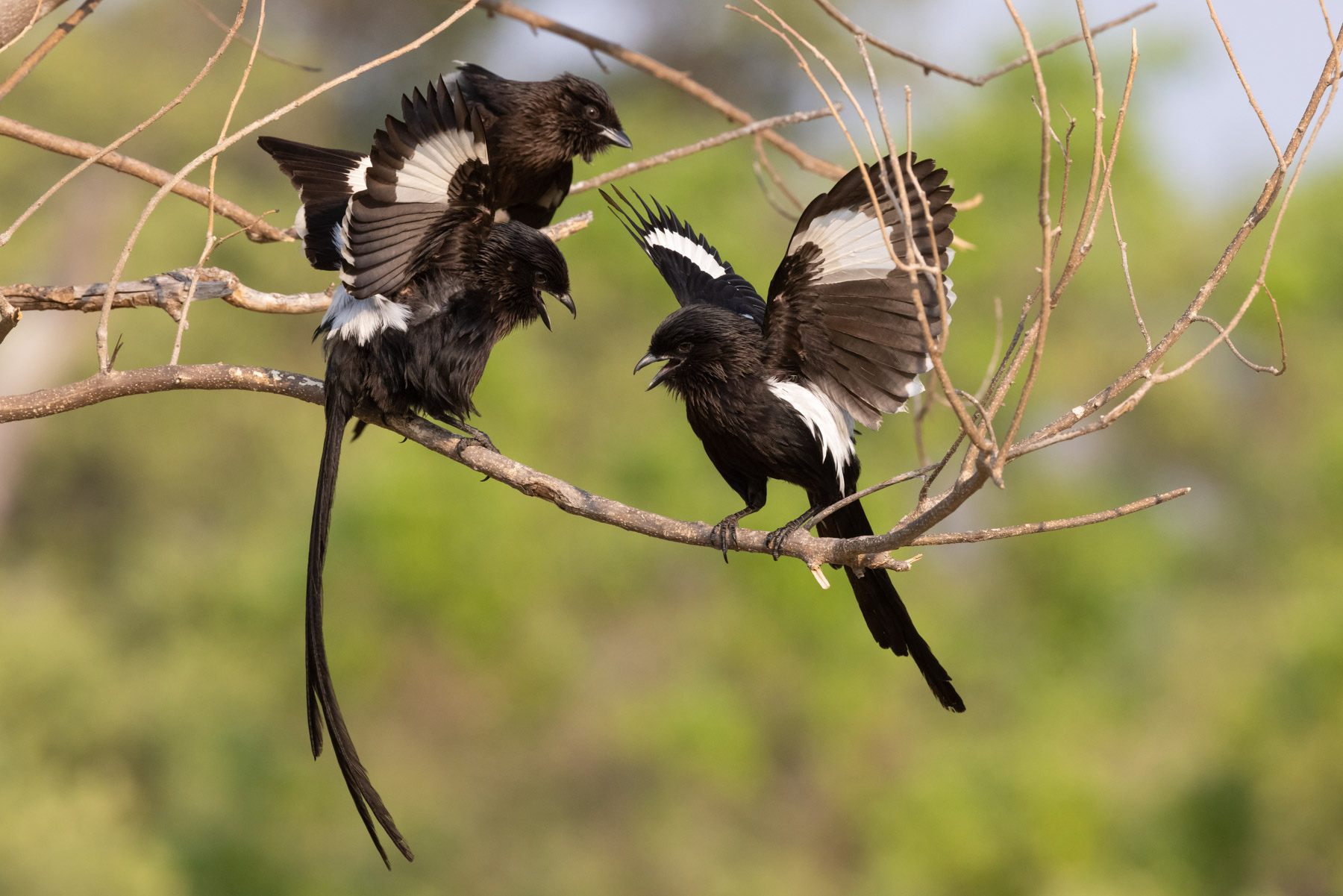
Noisy and gregarious, Magpie Shrikes look fantastic when they display (image by Bernd Rohrschneider)

A large male Nile Monitor sticks his tongue out on the edge of the Chobe River (image by Bernd Rohrschneider)

Yellow-billed Oxpeckers search an African Buffalo for lunch (image by Bernd Rohrschneider)

A herd of Impala watch a leopard stroll by. They could bark and run off at any minute if they sense the leopard will turn (image by Bernd Rohrschneider)

A female Impala jumps over a river canal in Botswana’s marshlands (image by Bernd Rohrschneider)

A spectacular encounter with a pair of African Wild Dogs fighting over the leg of their freshly caught impala (image by Bernd Rohrschneider)

“Mum can I have a drink now that I’ve done my swim?” (image by Bernd Rohrschneider)

Two Plains Zebras share a tender moment on our Botswana safari (image by Bernd Rohrschneider)

Can you ever have too much time with newborn leopard cubs? (image by Bernd Rohrschneider)
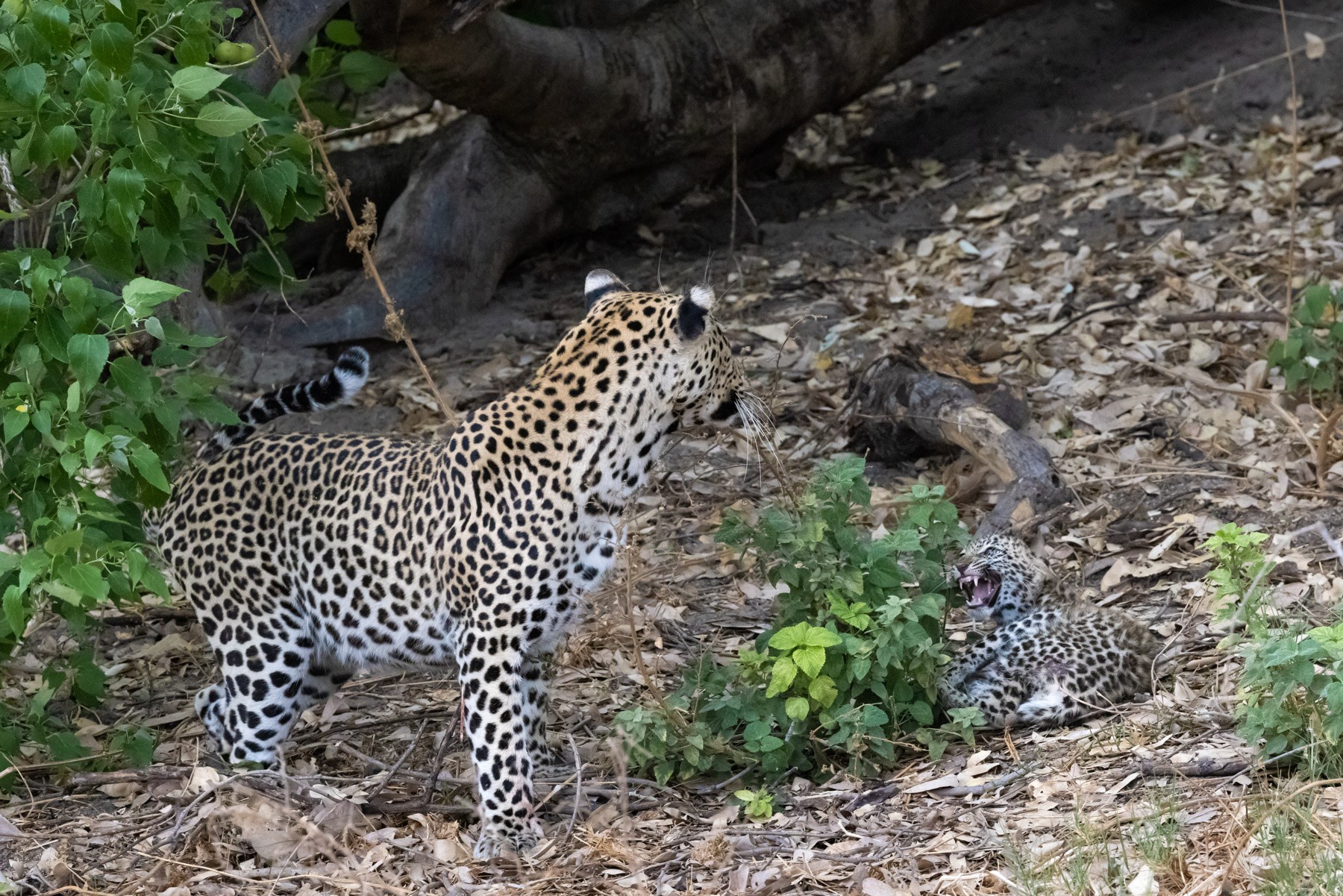
A leopard cub has a hissy fit with its father nearby (image by Bernd Rohrschneider)

Two playful leopard cubs playfight in a tree (image by Bernd Rohrschneider)

A large bull elephant takes a dust bath in Botswana (image by Bernd Rohrschneider)

Reflections of drinking Lechwe in the river (image by Bernd Rohrschneider)

A pair of lions keep watch for prey (image by Bernd Rohrschneider)

An amazing safari with a leopard family (image by Bernd Rohrschneider)

A beautiful lioness surveys her world (image by Bernd Rohrschneider)

Portrait of a Burchell’s Sandgrouse (image by Bernd Rohrschneider)

Portrait of an African Wild Dog. Botswana is probably one of the most reliable places in Africa to see these creatures in the wild (image by Bernd Rohrschneider)

A leopard drags off her fresh impala kill to a safe spot (image by Bernd Rohrschneider)
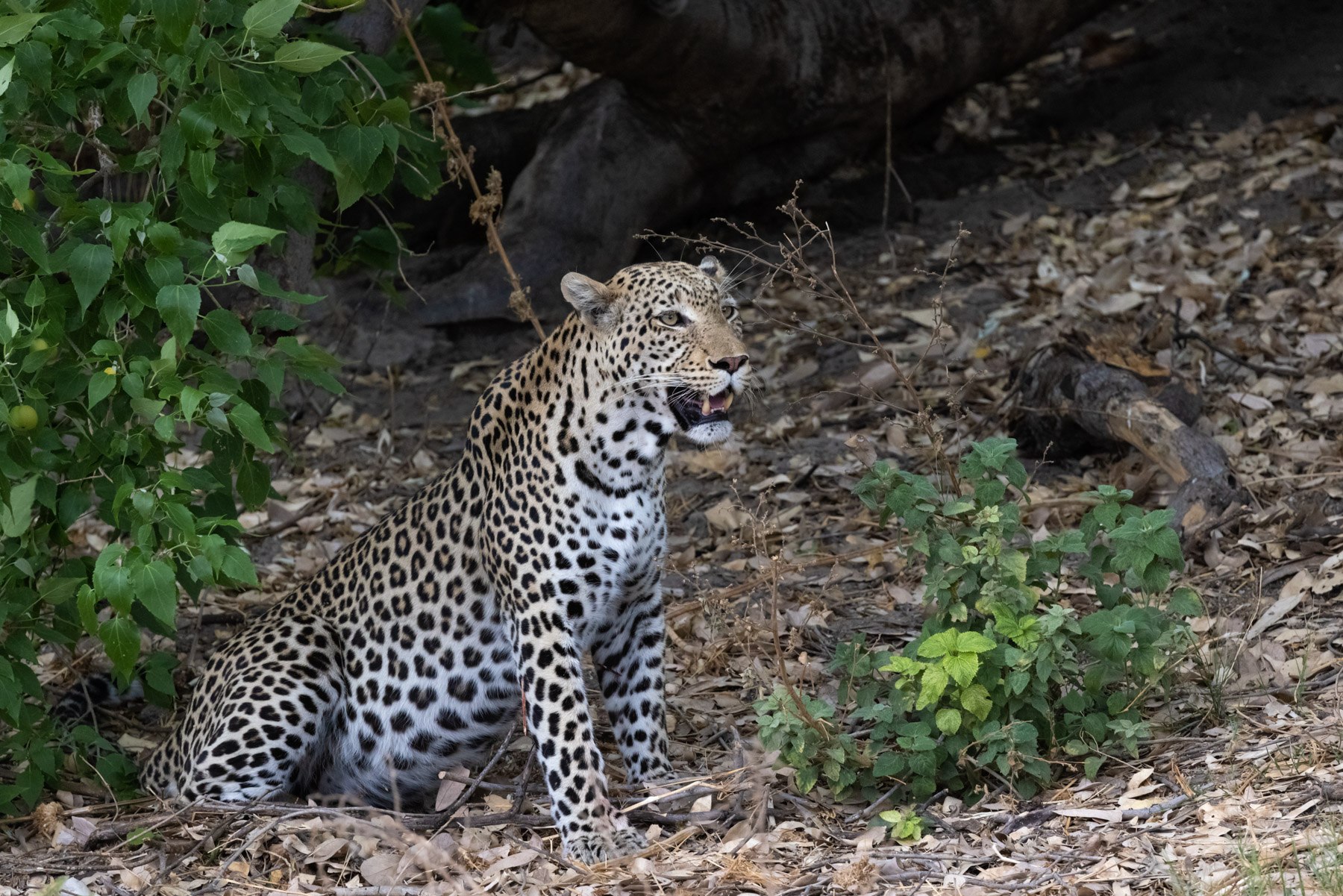
A leopard father takes a break from parenting his two adorable cubs (image by Bernd Rohrschneider)
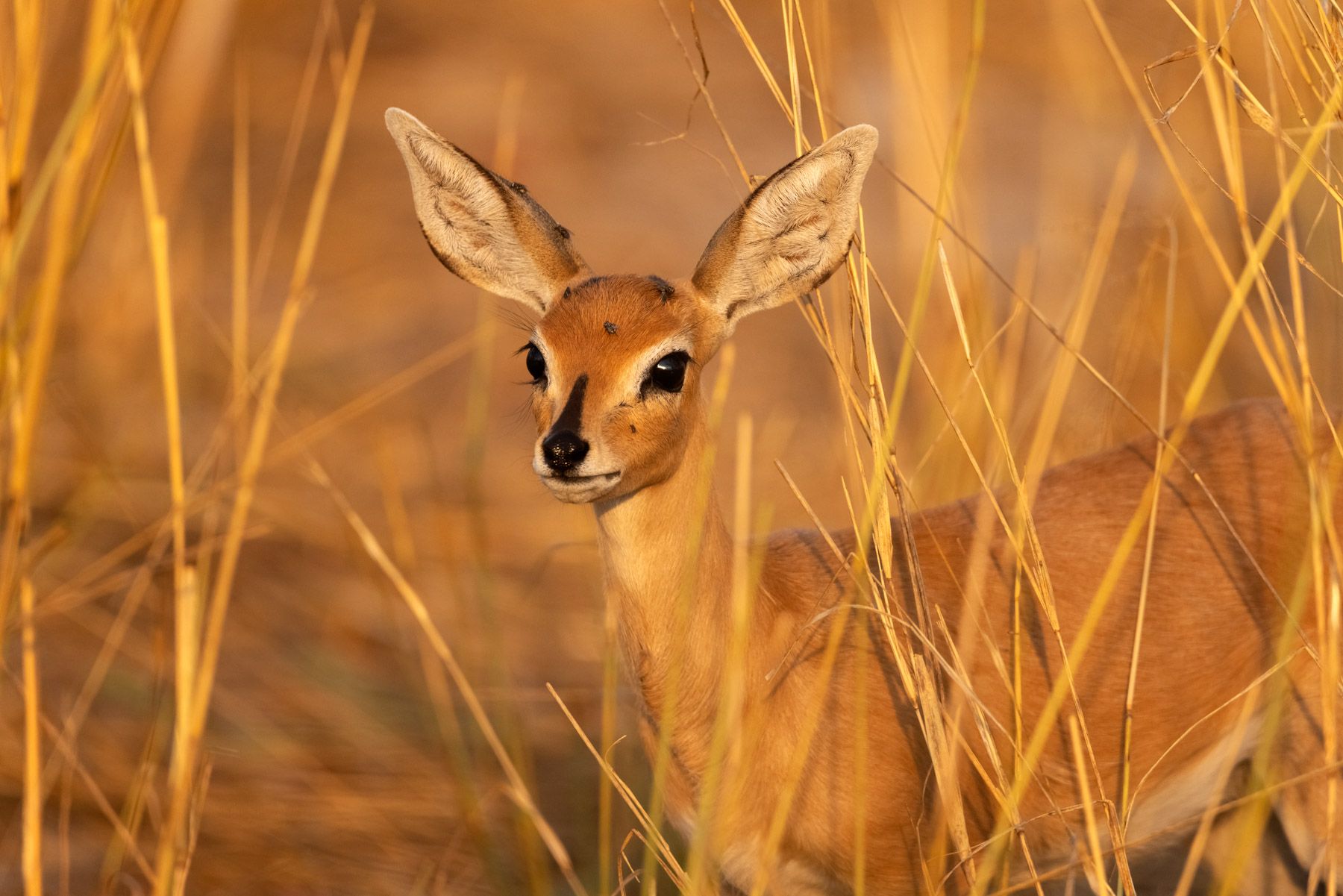
A beautiful Steenbok bathed in the golden glow of sunset (image by Bernd Rohrschneider)

Grey Goaway Birds or Grey Louries are as well known for their calls as they are for their zany crests (image by Bernd Rohrschneider)

Southern Ground Hornbills almost always hunt in pairs. They scour Africa’s grasslands in search of prey that includes snakes, small lizards and large insects (image by Bernd Rohrschneider)
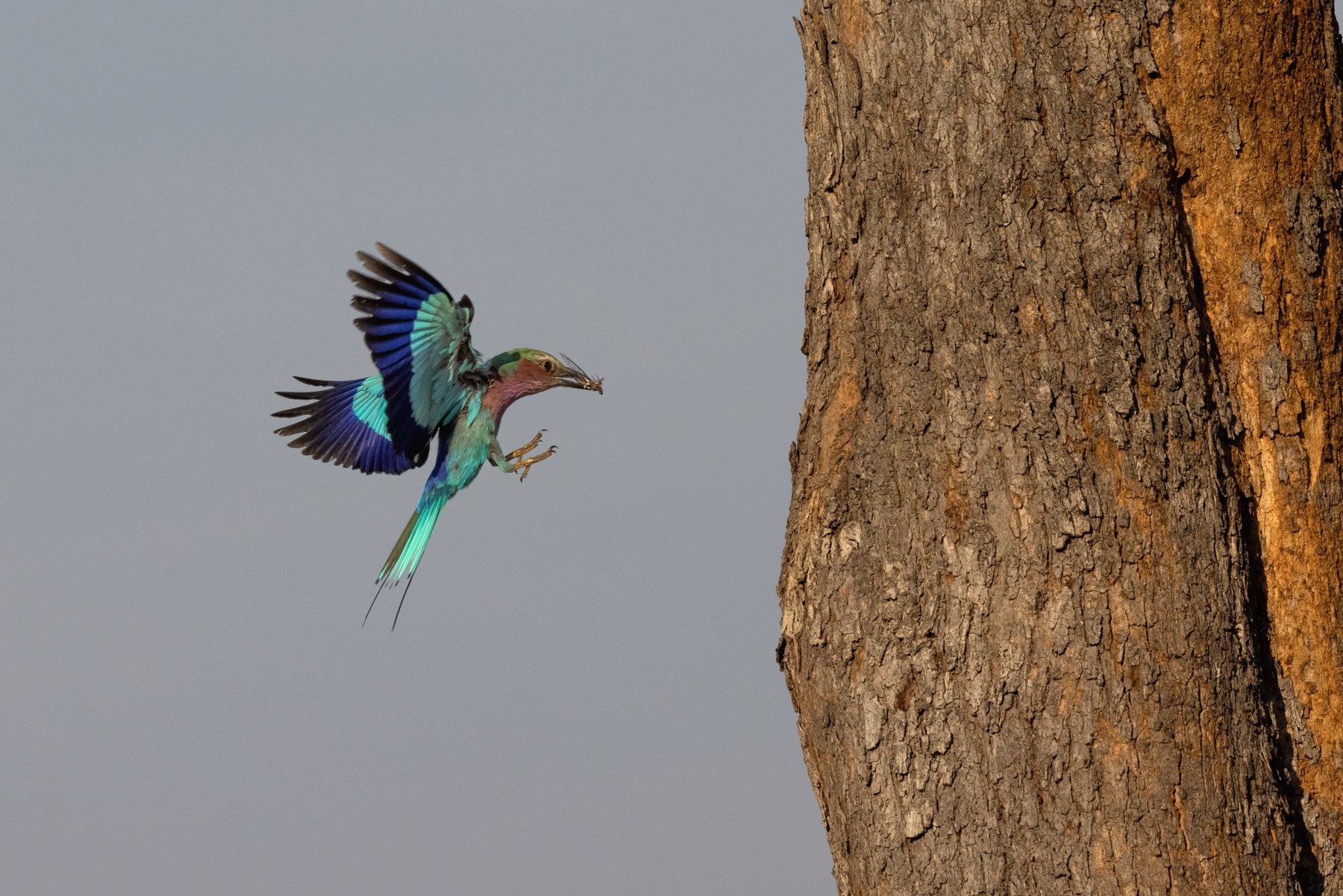
A nesting Lilac-breasted Roller flies in to feed an insect to its young (image by Bernd Rohrschneider)

A good roll in the dust is always the best way to end a Zebra siesta (image by Bernd Rohrschneider)

Lounge leopard on a tree in Botswana (image by Bernd Rohrschneider)

“Should I hunt?” A leopard enjoys a contemplative moment in Botswana (image by Bernd Rohrschneider)
After our smooth flight to Maun, the Wild Images Botswana 2021 tour group met at the beautiful Thalamakane River Lodge in the afternoon.
After checking in we started with a short walk in the garden of the lodge situated on the riverbank of the picturesque Thalamakane river. In the river, we saw our first Hippos from a distance and our first water birds of our tour. Meeting for a spectacular river sunset, our dinner was a great way to get to know each other and talk about our expectations and interests regarding the tour.
The next morning, we were collected by Shaka, our experienced local guide and driver for the whole tour. We loaded our luggage into the Landcruiser and then we drove out to the starting point of our safari, the amazing Xakanaxa in Moremi National Park. Our vehicle was very well equipped with multi-socketed inverters for charging our camera batteries and even a refrigerator for keeping drinks and other items cool during our safari. We were only a small group with myself and two guests so each photographer could use a whole row of seats in the car, allowing all of us to get into the right spot for photography at sightings. The weather was hot, about 36 °C. After leaving Xakanaka on good roads we eventually changed to a long dusty road as we drove towards Moremi. En-route we had our first sightings of elephants, steenbok, impalas and various birds. After passing the entrance gate to the famous Moremi National Park we reached our mobile tented camp in the early afternoon.
Everything was already set up by our busy camp crew. The mobile tented camp was surprisingly luxurious. The tents were big enough to stand upright inside, equipped with a mattress and a simple toilet with a bucket shower. We had a short break and then we started our first game drive when the light turned better for photography. Moremi is a fascinating place with a lot of wetlands and dead trees drowned during former monsoon floods. Elegant Lechwe antelopes, elephants, hippos, Plains Zebras, Squacco Heron and Verreaux’s eagle-owl at dusk were all great photo subjects for our first Botswana safari. Our tour was timed well to take advantage of the impala breeding season so we saw a lot of very cute Impala babies exploring their new yet dangerous world.
By the time we finished our first safari, it was dark and enjoyed recapping our day full of impressions at the bushfire and over a delicious diner. On our first night in our comfortable tents we fell asleep listening to the sounds of a nearby hyena and hippos.
From then we had a daily routine: get up early before dawn, have a little breakfast, start our morning drive at sunrise, return for lunch and a break at noon when the activity of the animals calms down and go for a second drive in the afternoon.
Our first three days in Moremi National Park were very rewarding for it was here we started to see our first African Wild Dogs.
Over two different days we followed this active pack of six dogs as they engaged with each other and searched for prey. African Wild Dogs are very social animals and when they are active you can always watch a lot of interesting behaviour. On the two times we saw them we had great opportunities for photography of these amazing animals at short distances. The second time we even caught them shortly after they had made a kill of a young impala. It was impressive to see and photograph them while they fought for food. We even watched two dogs, each pulling one end of an Impala leg! We were extremely happy to find these Wild Dogs so early in our tour. Botswana is one of the last places to see them, but even here it’s not easy since they have huge territories.
During our time in Moremi we spent a long time with a herd of about a hundred Plains Zebras watching them graze. From time to time some of them broke into fights or stopped to dust bathe. Photographing a big herd of zebras like this is always fascinating. We also took photos of Lechwe antelopes, elephants bathing in the dust, Side-striped Jackal and Vervet Monkeys.
By the time we finished our first section in Moremi, our bird list already passed the threshold of a hundred different species! We saw the huge, and rare, Wattled Crane, an impressive Martial Eagle, the rarely seen Black Sparrowhawk, Saddle-billed Stork, Hadada Ibis and African Sacred Ibis, Malachite and Woodland Kingfishers, beautiful coloured Little Bee-eaters and our first Carmine Bee-eaters, a lot of Lilac-breasted Rollers, Meyer’s Parrot, Burchell’s Sandgrouse, Golden-tailed Woodpecker and Magpie Shrike, just to mention a few. We also managed to find the endangered Slaty Egret. Moremi is definitely one of the best places to see this bird. In fact, we have never missed it on our tour!
Our lovely few days in Moremi came to end so we left for our next destination, the stunning reserve of Khwai. During our long drive we saw lots of Lechwe antelopes, zebras, Greater Kudus, Tsessebees and African Buffalo.
Passing by a large waterhole, we stopped to watch a drinking elephant bull and suddenly we heard a loud roar just behind our vehicle! Looking around we saw two male Lions run out of the bushes and vanish in the thicket again very fast. We tried to find them at first without success, but a short time later the Lions again came out into the open and we noticed they were being chased by the Elephant bull!!! The action was so fast that it was nearly impossible to get good images of the elephant and the lions together, but all of us caught some images of the running lions at least.
In the afternoon we finally reached the Khwai concession after driving through the small village of the same name and we began to enjoy the beautiful nature on our first Khwai safari. We photographed African Buffalo with Oxpeckers and a cute Steenbok in wonderful, golden sunset light.
After the long drive we were happy to wash off the dust under the bucket shower and sit around the campfire talking about the adventures of the day. The camp was situated in a fantastic place near a water hole and we all started to get excited about what we might see over the coming days in the Khwai area.
The next day we saw lots of White-backed Vultures soaring so we followed them to an Elephant carcass. Joining them on their carrion breakfast were different vultures, Marabou Storks and even some crocodiles! Fortunately, the wind was not blowing in our direction. Being downwind from a rotting carcass is not fun at all so we enjoyed some time with this vulture dinner photographing the bird activity in the scenery before we moved on with our safari.
In a tree, we spotted four cute Southern White-faced Owls perched on the branches, three fledged young and one adult. They offered us some nice photo opportunities although it has been a bit challenging to find a gap through all the branches.
Later that afternoon we found our first Leopard, a beautiful female. She was very active, walking continuously through the rough terrain and not always easy to follow, but as always, Shaka did a fantastic job with following here and he enabled us to get some really good images. In the last light, the leopardess finally climbed a log. What an amazing privilege to spend more than one hour with her!
While they are not generally allowed in Botswana’s reserves, it is permitted to do them in Khwai so, after sunset, we started a night drive scanning the surroundings with a spotlight. This night drive was surprisingly productive, even if it was a bit difficult for photography. We saw Scrub Hares, jumping South African Spring Hares, a Spotted Genet and even an African Wild Cat!
The next morning, our cat luck continued with another beautiful sighting of a leopard! Again, it was a female and we accompanied her for many hours. We followed her to the Khwai river where we watched her drink while some impalas looked on with alert. After a while, the leopardess walked to her tree where we discovered she had stashed her morning prey. We looked up to find a baby Impala hanging down from a branch up in the tree. The Leopard climbed up the tree, picked up her impala prey and jumped down again, then she dragged it for a distance until she reached a bushy terrain. She then called for her cub, but it didn’t appear. We decided to leave her on her own for a while and return after our midday break. During our break, there was a short thunderstorm, but just at the right time, the rain stopped just as we left on our afternoon drive. We returned to the leopardess and found her together with her two month old baby cub! What a fantastic sighting! What a fantastic leopard day with so many different behaviors!
The following night safari offered sightings of a distant Spotted Genet and of course several Spring Hares and Scrub Hares as well as a Southern White-faced Owl. At dinner, we celebrated our leopard day with a glass of red wine. The chef did an excellent job and was able to make delicious meals every day on a level one might expect in a restaurant but not in the bush with simple facilities. We even enjoyed cakes and desserts every day.
Our time in Khwai flew past way too quickly. We would have loved to spend more time there but our next reserve, Savuti, was calling so we drove out the next morning to reach it. On the dust road, we discovered the tracks of an elusive Aardvark. We made a short stop to watch a pride of lions feeding on a lechwe kill in the distance on the other side of the river and
later we found an African Rock Python in a tree. Thankfully we were in a place where we could get out of the car so we went around the tree in order to find the right gap to get a good position for photos of the head. In the end, we all got nice images of that huge snake but it was a bit challenging trying to get a photo of him with his tongue out.
On our way to Savuti we travelled over the Mabebe depression which is a huge plain. With our binoculars, we could spot giraffes, buffalo, elephants and ostriches. In the intense warm wind, we saw several dust devils racing across this huge open area.
In the evening we finally reached Savuti, which forms a part of the Chobe National Park. Savuti was very dry during our tour and thankfully, there were some artificial water holes that attracted many animals to drink. Big parts of the famous Savuti marsh burnt down in a bushfire some months ago. The burned landscape allowed us to see some rocky outcrops forming a very interesting landscape that was very different to Khwai. Again, our superb camp crew already had built up our camp in another beautiful place that would be our home for the next three nights.
The moon was shining through the clouds and the calls of an African Scops Owl made for a fantastic atmosphere when we sat at the campfire with our drinks, enjoying the mood of the African night. At around 3am I heard the typical sound of a leopard, which resembles the sound of sawing wood with a hand saw. It was so close, it sounded like it was right in our camp!
The next morning the temperature was pleasantly cool so we drove out to search for the famous Marsh Pride of lions. We scanned the extensive plains but we heard that this big pride, with 35 Lions had not been seen the last four days. We found one dominant impressive black-maned male Lion doing what Lions like doing best – lying on the ground and sleeping.
The bird life in Savuti is quite different to that in Moremi and Khwai. We saw Kori Bustard, Red-crested Korhaan, Northern Black Korhaan, Gabar Goshawk, Temminck’s Courser, Black-winged Pratincole, European Bee-Eater and stunning Crimson-breasted Shrike, just to name a few.
Furthermore, the waterholes were very productive with drinking elephants, warthogs and Helmeted Guineafowl.
In the afternoon we had another spectacular encounter very close to our campsite. We spotted our next female Leopard and Shaka managed to follow her in difficult terrain, with lots of bushes and trees, while we tried our best to avoid the branches hitting us in the car. It was worth the effort. Soon the leopardess was calling for her young and a cute cub appeared! We were thrilled to find she was actually nursing her young. As we sat watching the leopard mother, unbelievably soon after, another leopard emerged from the bushes! This was a huge male and the father of the leopard’s cubs. He was feeding on a baby impala kill and we watched the cub pick up an impala leg so the male let it go with its prey. Just when we thought this amazing sighting was over, a second cub appeared, allowing us to witness the behavior of a whole leopard family of four individuals! We watched the young cubs playing together and climbing on a tree. One of them had some difficulties coming down again so the leopardess had to show it how to climb down the tree. When the light disappeared, photography became difficult in the twilight and we stayed with the leopard family until they went further in the bush. What a completely fantastic experience! It was very unusual to see a male leopard together with a female and young and it was so nice to see how kind he was to the cubs. Of course, the leopard encounter was the main topic of conversation over dinner as we all reeled with excitement over seeing something that was truly unique in African safaris.
That night we had elephants visit our camp. We could hear the sound of their shuffling feet as they made their way through our tents.
The next morning, we had our only sighting of two cheetahs on our tour. We found two cheetah brothers lying in the open but not really doing anything so, moving on, we also found a beautiful pair of Lilac-breasted Rollers bringing insects to feed their young in a tree hole so we stopped to try and capture that perfect roller in-flight shot while we watched these magnificent birds coming and going from their nesting hole. Nearby we saw some breeding herds of elephants with their young. Watching baby elephants is always a highlight of our tours and they are nearly always a guest favourite to photograph.
While taking our showers that evening under the open sky it started to rain after we heard some thunder in the distance. Our tour takes place at the beginning of the rainy season so we can have a chance at photographing some beautiful stormy African skies. Alas, this storm was at night so we had to be content with listening to it all from the shelter of our warm, dry tents.
On the following afternoon, we managed to get our best Lion images of the tour. Firstly we found three male Lions and then a short time later we found a very big male lion together with his female. We assumed that one day that large male will take over his own pride which will be an exciting time in Savuti and definitely something to keep an eye out for on future Wild Images tours. Luckily we managed to photograph these lions in the beautiful golden evening light. We couldn’t have hoped for better.
Our last morning in Savuti arrived too quickly! On our last night in the reserve we had a Honey Badger visit our camp and empty a glass of jam! He also tried to open two other glasses without success.
Following a tip about the location of an aardwolf den, we tried to find it on our last early morning in Savuti. After a while of searching, we successfully found the den and we were delighted to find an Aardwolf peering out of the entrance! It was the first time any of our group had seen an Aardwolf, which is a younger cousin of the larger hyena family.
That same morning we saw some running bat-eared foxes and finally, we found some lions which formed a part of the Marsh Pride. We counted 16 individuals sleeping! Some of them raised their heads when they saw us but most just lounged around. Just before we left Savuti, we spotted a lioness with her three little cubs. We also found and photographed the rarely seen Denham’s Bustard before our long drive out of Savuti to reach our final destination of the tour, the Chobe River, where we spent our last two night of our tour. On our first late afternoon safari in Chobe we drove along the beautiful river of the same name, that forms the border between Botswana and Namibia. We saw impalas, giraffes, a big herd of African Buffalo, many Jacobin Cuckoos and an elegant Amur Falcon.
On our last full safari day we saw two sleepy male lions, yet nobody raised the camera for them, which was a good sign that we already had much better encounters with lions on our trip.
The Chobe River is stunning and our tour timed beautifully with the arrival of flocks of photogenic Carmine Bee-Eaters which are always a tour favourite. Along the Chobe River we also found a huge gathering of African Openbill Storks feeding on snails with their specialized bills. What wonderful things to see on our way to Kasane to have our PCR tests done in time for our flights home.
On our way to pretty Kasane we spotted some magnificent Sable grazing before we got our tests done in a private laboratory without problems.
From there we started our boat trip on the Chobe River, which was a great opportunity to get some new perspectives with low angle photography from the river. We were very lucky to photograph crocodiles, Nile Monitors, hippopotamuses, Blue-cheeked Bee-Eaters, Pied Kingfisher, White-crowned Lapwings and a Purple Heron. The absolute highlight of our boat cruise, however, were the elephants we photographed drinking and bathing in the river. We even saw some of the young playing in the water which was hilarious to photograph.
On our last morning, it was time to say goodbye to our fantastic camp crew and all of us felt truly sorry to see them go after such a wonderful tour. We enjoyed a last morning drive along the Chobe River in a beautiful sunrise so we captured some wonderful images of a silhouetted Baobab tree during the blue hour.
Our wonderful bird sightings continued when we found a Great Spotted Cuckoo, Common Cuckoo and the strange singing Tropical Boubou, pushing our bird list up to 189 species. As a grand finale, we spent time with a massive herd of around 300 elephants that came down to the river’s edge to drink and bathe.
From there we all had to drive to Kasane airport where our tour finally ended. After some absolutely breathtaking wildlife encounters none of us really wanted the tour to end. We were blessed with some extremely rare and unique sightings alongside some unrivalled cat and dog encounters to crown off our trip. Wild Images runs one of the most sighting intense mobile safari tours in this incredible part of Africa. Already we are dying to return in 2022!




























































